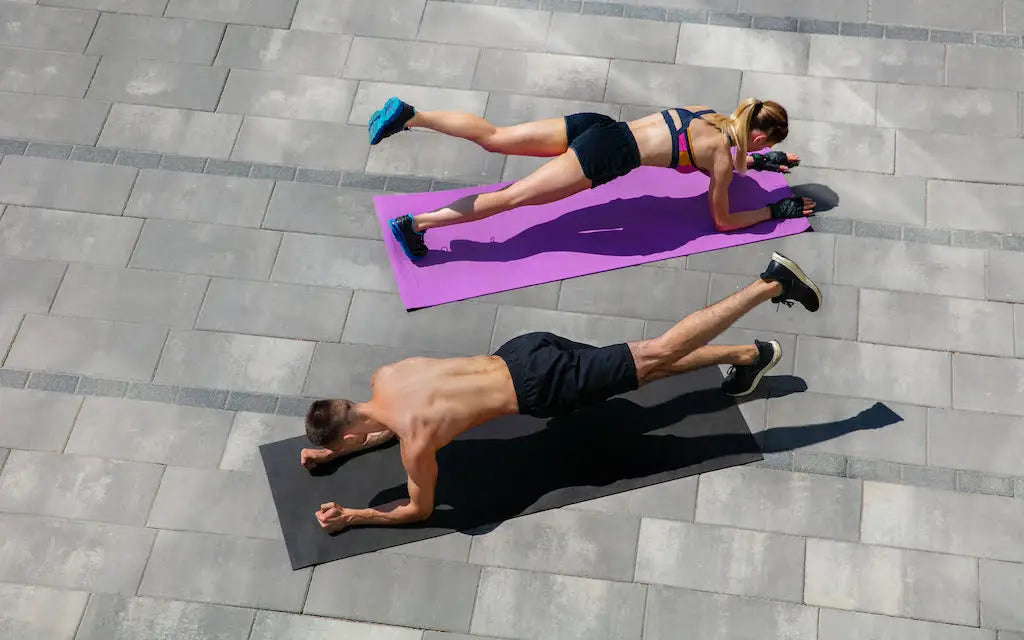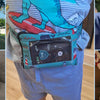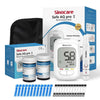Exercise with an insulin pump
-
Published on
Last updated on

Sports with an insulin pump - and sports with diabetes - we found a challenge in itself. But exercise is very important in diabetes. Sport keeps you fit and reduces stress. That's important because stress disrupts blood sugar levels. Still, you can be afraid to play sports. Or you may be afraid of hypo's. But sports and diabetes can go well together. Don't forget: there are top athletes with diabetes.
If you're injecting insulin, you have to be careful with very strenuous efforts, such as endurance sports like marathon running and cycling. This is because your blood sugar can suddenly rise or fall extremely, which can be dangerous. But there are top athletes with diabetes, so it's absolutely possible. Good regulation and advice from a doctor are then necessary. Less sensible are sports in which a life-threatening situation can arise in case of a sudden hypo, i.e. an attack of too low blood sugar. Such as diving or mountain climbing.
Sport has a positive effect on your body. Sport also influences your blood glucose level: it goes down and you can get a hypo. By measuring your blood glucose values, you can react in time and prevent a hypo. Below you will find tips to prevent hypo's. These can differ from person to person. Consult with your health care provider and try out what works for you.
During sports you run the risk of hypo's. You can prevent them by giving less insulin before exercising, taking some extra carbohydrates or adjusting the target value on your insulin pump. Always discuss this with your health care provider. Many insulin pumps have adaptations for sports. Kaio has Medtronic's 670g and increases its temporary target one hour before and 2 hours after exercise. He's on freerunning and comes out of trampoline jumping fast in a hypo. Always measure before exercising. If your blood glucose level is above 8 mmol/l and below 20 mmol/l, you can start exercising!
When you start exercising, the blood glucose is slightly higher, but it goes down again due to the effort. Keep drinking enough as well. During strenuous activities you drink 0.5 to 1 liter per hour.
Your muscle cells replenish their glucose supply after exercise, with glucose from your blood. Mainly the first two hours after exercise. The increased insulin sensitivity from exercise can last for 24-48 hours. So you have to check extra, to prevent a hypo afterwards.
With sports, it's just a matter of trying out what works for you: do you keep the pump on or do you disconnect it? Of course, it depends on how you react to sports and whether you do contact or water sports, for example. And if you prefer to stay connected, this can of course also be done in different ways, depending on what you are going to do. Of course you don't want your pump to get in the way.
We found sports with an insulin pump a challenge in itself. Kaio regularly lost his sensor for example only after we started to use the Dia-Band that was solved. Pump bags were not handy and sometimes he refused a bag completely. That's why we developed several products that work great for sports and other activities with an insulin pump:
The Dia-Belt insulin pump bag is perfectly suitable for sports. Because the Dia-Belt does not slip, you can move so freely that it makes you forget about your diabetes. The mini bag is elastic and takes the shape of the contents. The Dia-Belt can be worn under or over clothing. Of course, your smartphone and/ or power pack also has a place in the pouch. The Dia-Belt has two feed-through openings so you don't have to turn the belt over when you want the shortest possible route to your infusion site. The additional feed-through opening can be used for the cable of the headphones during exercise.
Dia-T.Top is perfect for sports. The T.Top has 2 integrated inner pockets for your insulin pump one on either side. So you are free to enjoy your sport without worrying about the insulin pump. In the inner pockets feed-through openings for your infusion set are available one in the top and one in the bottom of the pocket. This allows you to comfortably wear your insulin pump under your sportswear.
Have you ever experienced your sensor or pod coming loose (from your skin) during a workout? The Dia-Band keeps helps to keep all sensors in place like the Medtronic guardian, Dexcom or the Freestyle Libre including an attached bubble smart reader or Maio Maio. When playing, games or exercising, Dia-Band will help to keep your CGM or pod in place.
Careful with endurance sports
If you're injecting insulin, you have to be careful with very strenuous efforts, such as endurance sports like marathon running and cycling. This is because your blood sugar can suddenly rise or fall extremely, which can be dangerous. But there are top athletes with diabetes, so it's absolutely possible. Good regulation and advice from a doctor are then necessary. Less sensible are sports in which a life-threatening situation can arise in case of a sudden hypo, i.e. an attack of too low blood sugar. Such as diving or mountain climbing.
Sports and your blood glucose levels (with and without insulin pump)
Sport has a positive effect on your body. Sport also influences your blood glucose level: it goes down and you can get a hypo. By measuring your blood glucose values, you can react in time and prevent a hypo. Below you will find tips to prevent hypo's. These can differ from person to person. Consult with your health care provider and try out what works for you.
For sporting activities
During sports you run the risk of hypo's. You can prevent them by giving less insulin before exercising, taking some extra carbohydrates or adjusting the target value on your insulin pump. Always discuss this with your health care provider. Many insulin pumps have adaptations for sports. Kaio has Medtronic's 670g and increases its temporary target one hour before and 2 hours after exercise. He's on freerunning and comes out of trampoline jumping fast in a hypo. Always measure before exercising. If your blood glucose level is above 8 mmol/l and below 20 mmol/l, you can start exercising!
During sports
When you start exercising, the blood glucose is slightly higher, but it goes down again due to the effort. Keep drinking enough as well. During strenuous activities you drink 0.5 to 1 liter per hour.
After sports
Your muscle cells replenish their glucose supply after exercise, with glucose from your blood. Mainly the first two hours after exercise. The increased insulin sensitivity from exercise can last for 24-48 hours. So you have to check extra, to prevent a hypo afterwards.
Sports with an insulin pump
With sports, it's just a matter of trying out what works for you: do you keep the pump on or do you disconnect it? Of course, it depends on how you react to sports and whether you do contact or water sports, for example. And if you prefer to stay connected, this can of course also be done in different ways, depending on what you are going to do. Of course you don't want your pump to get in the way.
We found sports with an insulin pump a challenge in itself. Kaio regularly lost his sensor for example only after we started to use the Dia-Band that was solved. Pump bags were not handy and sometimes he refused a bag completely. That's why we developed several products that work great for sports and other activities with an insulin pump:
The Dia-Belt insulin pump bag is perfectly suitable for sports. Because the Dia-Belt does not slip, you can move so freely that it makes you forget about your diabetes. The mini bag is elastic and takes the shape of the contents. The Dia-Belt can be worn under or over clothing. Of course, your smartphone and/ or power pack also has a place in the pouch. The Dia-Belt has two feed-through openings so you don't have to turn the belt over when you want the shortest possible route to your infusion site. The additional feed-through opening can be used for the cable of the headphones during exercise.
Dia-T.Top is perfect for sports. The T.Top has 2 integrated inner pockets for your insulin pump one on either side. So you are free to enjoy your sport without worrying about the insulin pump. In the inner pockets feed-through openings for your infusion set are available one in the top and one in the bottom of the pocket. This allows you to comfortably wear your insulin pump under your sportswear.
Have you ever experienced your sensor or pod coming loose (from your skin) during a workout? The Dia-Band keeps helps to keep all sensors in place like the Medtronic guardian, Dexcom or the Freestyle Libre including an attached bubble smart reader or Maio Maio. When playing, games or exercising, Dia-Band will help to keep your CGM or pod in place.





